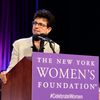Last month, the National Institute on Retirement Security reported that women are 80 percent more likely than men to be impoverished at age 65 or older. Women’s longer lifespans partly account for this disturbing statistic, but a lifetime of disadvantages in educational and career opportunities, unequal wages, and caregiving responsibilities are behind the retirement insecurity that many senior women face. Their late-in-life economic prospects are dismal, and they are much poorer than men.
In 2014, The New York Women’s Foundation released a report, Blueprint for Investing in Women 60+, highlighting the challenges faced by New York City’s older women, who make up much of the 31 percent of its seniors living in poverty.
The report found that older women – particularly low-income older women of color and immigrant older women – represent a significant and growing segment of New York City’s population. The City is home to 1.4 million seniors with women outnumbering men three to two at age 60 and two to one at age 80. They play vital roles in tens of thousands of families across some of the poorest communities of the city – managing housekeeping and child-minding duties so adult children can put in grueling work hours, single-handedly raising some 100,000 grandchildren, and caring and providing for dependent relatives of all ages.”
These burdens have severely impacted the ability of older women to address their own needs, leaving them particularly vulnerable to health and financial difficulties.

Unsurprisingly, the report also found that older women’s health issues tend to increase with both age and poverty. For most of their lives, they have had inadequate access to appropriate health care services, fitness options, and nutritious food. For most of their lives, they have neglected their own health issues while providing for the needs of others.
Older immigrant women and women of color are particularly vulnerable to conditions of poverty, with 40 percent of NYC seniors identifying as non-white and 46 percent born abroad. This is in stark contrast to the demographic of the NYC senior population in 1965 when the Older Americans Act was first passed. At that time, 85 percent of older New Yorkers were white, US citizens, and English speaking. The current aging structure, shaped by OAA, largely operates under the assumption that this population is relatively small; ethnically, racially and linguistically homogeneous; free from child-raising and family support responsibilities; and largely protected from poverty and ill-health thanks to Social Security and Medicare and Medicaid programs. This shift in population reflects a dire need to re-examine the services available to seniors to meet their needs as they exist today.
The report offers experts’ four key strategies to help address the critical needs of this population: (1) expanding access to affordable housing; (2) increasing access to currently-available entitlements; (3) supporting financial management capacities; and (4) expanding employment options.

It also offers guidance for direct service providers, philanthropy, and government agencies as to how they can better support the healthy aging and financial security of this population. Recommendations include: continuing to build effective and innovative appropriate nutrition and fitness programs; expanding support for care providers—both older women caregivers and those that care for older adults; and promote collaboration across sectors, cultures and generations in order to reach more underserved groups including LGBT, immigrants, and women with disabilities.
Financial insecurity is the high price that too many women pay, particularly as they become seniors. Attention must be paid to older women, whose worth far exceeds the value of their prime employment and childbearing years. Our grantee partners, including LiveOn NY, GRIOT Circle, MinKwon Center for Community Action, Center for Family Life/SCO Family Services, and United Community Centers, advocate for better policies, and develop and carry out programming that improves the quality of life for New York City’s senior women, but with greater, broad-based stakeholder engagement, so much more could be done.
